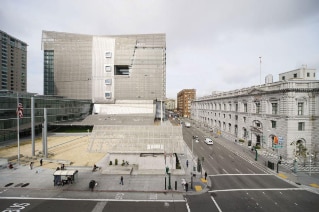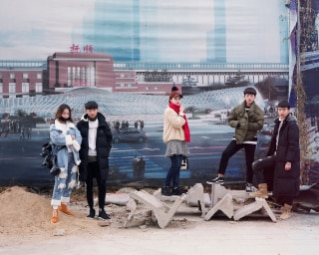In more complex terms, interaction design is a discipline that borrows from product, industrial, graphic, interface and web design, as well as cognitive psychology, human computer interaction, computer science, information communication technology (ICT)—and architecture. Interaction design is never the same thing in two different places. As many histories of interaction design exist as there are disciplines that borrow from them. The most interesting and instructive work is often found at the overlap of different approaches. Gillian Crampton Smith, leader of the interaction design track at the IAUV in Venice with her husband, architect Phil Tabor, founded the Royal College of Art's Computer Related Design master's program (now the Designing Interactions program) and the Interaction Design Institute Ivrea in Italy. Working from her background as a graphic designer, she expanded the tools for interaction design to incorporate narrative, video prototyping and critique. Her approach is a provocative practice in which designed objects stir dialogue, a method arguably more closely aligned with art than with design for use. On the other hand, the version of interaction design that came out of web-based "information architecture" was focused primarily on best practices for user research, interface design and software flow. In other words, a blend of user experience and human-computer interaction strategies.
Yet interaction design migrates reluctantly into architectural practice. Architecture schools tend to focus on the form-making possibilities of technology, on parametrics and computation, rather than the networked aspects of information and communications. These technologies privilege architectural representation above interaction. The tensions are in place: at the Yale School of Architecture in 2003, as Peter Eisenman extolled the ability of computers to produce "smooth space," as a contemporary manifestation of critical form, Keller Easterling looked behind the machine, showing the messy, cord-tangled backsides of computers as an antidote to the form-making taking place on the monitor. She highlighted the potential of these and other "organizational spaces" as sites for intervention and opportunity. Although there are outposts of support for interaction design in architectural education, the list of related programs is short: Columbia University's Network Architecture Lab, work at the University of Buffalo, and the University of Michigan, to name just a few islands of sympathy in architecture schools throughout the world.
This disconnect doesn't seem to stem from a lack of interest from interaction designers, as they have long been keen on designing at the scale of buildings and cities. In fact, the Interaction Design Institute Ivrea offered a course in "Building as Interface" in 2003, taught by architect Stefano Mirti. Practitioners approaching interaction design from this direction often cite a generation of architects and urbanists active in the 1960s and 70s. Theorists and designers like Jane Jacobs, Christopher Alexander, Reyner Banham, Cedric Price, and Archigram had been neglected by decades of mainstream academic architectural culture focused on form. Discarded by architects, interest in buildings and cities as systems of relationships has been renewed by interaction designers. "Urban computing" was born out of interaction design's interest in urbanism and design at a larger scale, but is a term unknown in most architectural schools. Today, designers, architects and artists use the open source Processing programming language, developed for creative use, and the Arduino environment for making physical objects interactive, sometimes unaware of the history that this kind of work builds on.
Perhaps challenges to architectural practice can only come from the periphery or from other disciplines. MIT's Architecture Machine Group in the 1970s had its genesis in the School of Architecture and Planning. Led by Nicholas Negroponte, ArcMac experimented with computing and peripherals for architectural and urban applications—it would later become the MIT Media Lab. Projects like "Mapping By Yourself" in 1976 suggested an early version of today's augmented reality; the Aspen Movie Map (1978–80) suggested a room-scale proto-Google Street View application. And SEEK, the 1970 installation at the SOFTWARE show at the Jewish Museum, used a robotic arm and video camera to move blocks in an environment inhabited by gerbils: it tried to anticipate their next moves. The Architecture Machine Group became the MIT Media Lab, which still resides in the School of Architecture and Planning—at least organizationally speaking.
Instead of bringing together users through machines, what if interaction design were reconceived to foster positive friction between different design disciplines? What would interaction design look like if it wasn't only (or even necessarily) digital, but if it genuinely melded architecture, industrial and product design, graphic design, art, video narrative, tiny technology, large scale networks, and so on? What would debates between the disciplines be like? What might win, and more importantly, what would they unearth about interaction design in general? What other disciplines might emerge and what new visions of the world might appear? The recognition that many other fields have dealt with these issues and continue to do so, may open up a larger conversation that reveals new relationships, isomorphisms, productive frictions—even interactions.
[1] Nate Nickerson, "What makes for good design," MIT Technology Review (110:3), May 1, 2007.
Fred Scharmen has worked with the offices of Greg Lynn FORM, Gehry Partners, Keller Easterling Architects, and Ziger/Snead. In 2010, he organized his own design, art and research consultancy as the Working Group on Adaptive Systems. He lives, works, and teaches in Baltimore, Maryland.
Molly Wright Steenson is a Ph.D. candidate in architecture at Princeton, where her dissertation focuses on computing in architecture and urbanism in the 60s and 70s. As a resident professor at the Interaction Design Institute Ivrea in Ivrea Italy, she led the Connected Communities research group. She blogs at Girlwonder.com.






